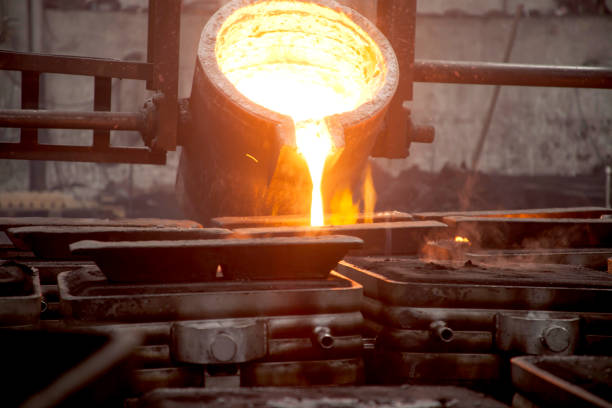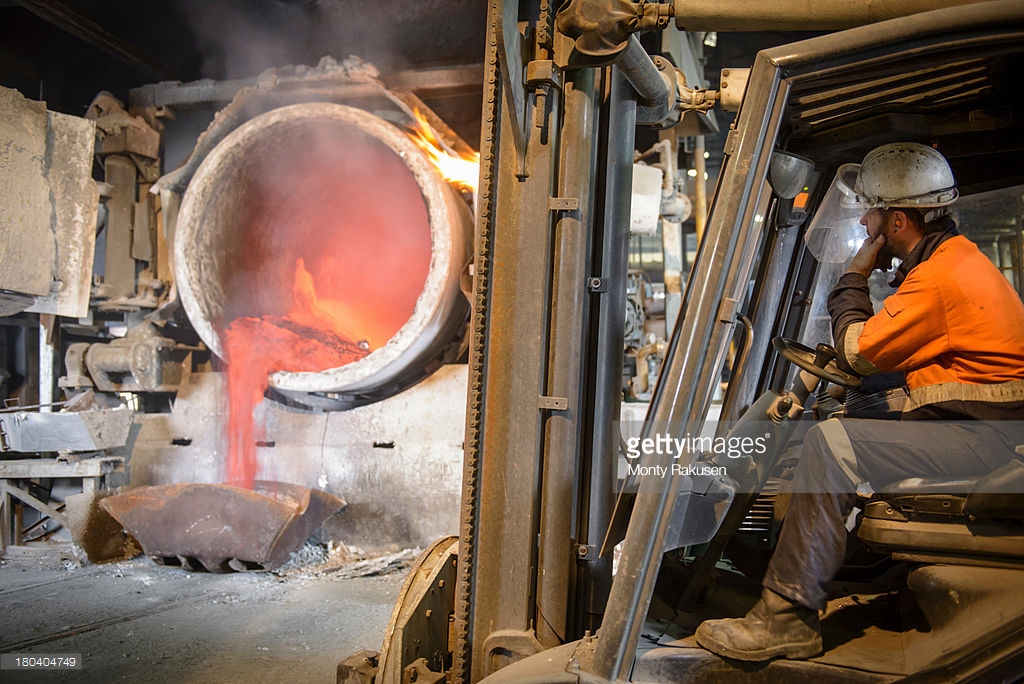Behind the Scenes of Wisconsin Aluminum Foundry: Next-Generation Production Processes
A Comprehensive Guide to the Conveniences of Making Use Of Aluminum From Foundries
Aluminum from foundries presents a variety of advantages that make it a useful material across numerous sectors. Its lightweight nature adds to set you back savings in transportation and improves total item efficiency. Additionally, aluminum's exceptional resistance to deterioration warranties long life and lessens maintenance demands. The benefits prolong beyond these aspects. Understanding the full spectrum of aluminum's residential properties and their implications can expose also deeper insights right into its role in modern applications
Recognizing Foundry-Grade Aluminum
Foundry-grade aluminum is a specialized product renowned for its outstanding residential or commercial properties and convenience in various applications. This sort of aluminum is generally produced through managed casting procedures, permitting exact control over its composition and microstructure. Therefore, foundry-grade aluminum exhibits remarkable mechanical homes, including superb strength and rust resistance, making it suitable for requiring atmospheres.
Along with its architectural stability, foundry-grade aluminum can be easily formed into complicated forms, supplying developers and designers with versatility in their projects. Its capacity to stand up to heats even more improves its charm for markets such as automotive and aerospace, where efficiency and reliability are crucial. Foundry-grade aluminum is commonly recyclable, adding to sustainability efforts. By using this material, producers can attain an equilibrium of performance, durability, and ecological obligation, making foundry-grade aluminum a favored selection for a large range of commercial applications.
Light-weight Qualities and Their Advantages
The light-weight buildings of aluminum from foundries use considerable advantages in different applications. Minimized transport expenses can be achieved as a result of the reduced weight, allowing for more efficient logistics. Additionally, the boosted product efficiency stemmed from making use of lighter products can cause improved functionality and user experience.
Reduced Transport Prices
Aluminum's light-weight homes considerably contribute to decreased transport expenses, making it an attractive selection for various industries. When contrasted to heavier products such as steel, aluminum permits lighter tons, making it possible for automobiles to carry more items efficiently. This decrease in weight can result in considerable cost savings on gas usage, as lighter vehicles need less power to operate. Furthermore, the ability to transport bigger amounts without exceeding weight limits boosts logistical effectiveness. Industries such as auto and aerospace benefit especially from these benefits, as they can enhance delivery processes and decrease general operational expenses. Using aluminum from foundries not only enhances transport but additionally supports sustainable practices by lessening carbon exhausts connected with heavy products transport.
Improved Product Performance

Rust Resistance: A Key Benefit
Aluminum from foundries offers phenomenal rust resistance, mainly because of its natural oxide layer. This protective finishing forms when aluminum is exposed to air, protecting against further oxidation and damage. Because of this, items made from aluminum can exhibit long-lasting resilience, making them excellent for various applications in difficult atmospheres.
Natural Oxide Layer
The natural oxide layer that forms on aluminum surface areas works as an important protection against deterioration. This thin, clear barrier creates when aluminum is revealed to oxygen, effectively protecting the underlying steel from numerous environmental elements. The oxide layer is both steady and long lasting, ensuring that aluminum maintains its integrity in time. Unlike other steels that may rust more quickly, aluminum's oxide layer stops the development of rust and various other detrimental compounds. This characteristic is specifically advantageous in industries where products are subjected to moisture or harsh chemicals. The presence of the all-natural oxide layer contributes considerably to the durability and dependability of aluminum products, making it a favored choice in countless applications.
Durable Durability
While many materials succumb to the devastations of time and environmental exposure, the long-lasting sturdiness of aluminum stands apart, primarily because of its remarkable rust resistance. This resistance is credited to an all-natural oxide layer that bases on its surface area, successfully protecting the metal from moisture, chemicals, and various other destructive representatives. Unlike steel, which can rust and deteriorate in time, aluminum stays undamaged, making it optimal for numerous applications, consisting of construction, vehicle, and aquatic industries. Its light-weight nature, integrated with durability, permits lowered maintenance prices and longer life expectancies in items. Consequently, aluminum from foundries provides a lasting alternative that reduces substitute regularity, adding to both financial efficiency and environmental duty. This resilience enhances its charm in many applications.
The Recyclability of Aluminum
Provided its considerable use across numerous industries, the recyclability of aluminum provides a significant environmental advantage. Aluminum can be reused forever without shedding its homes, making it a prime prospect for sustainable techniques. The reusing process requires only a fraction of the energy needed to generate brand-new aluminum from basic materials, minimizing greenhouse gas exhausts and conserving natural resources. Additionally, the recycling of aluminum draws away waste from landfills, adding to much more effective waste administration systems.

Cost-Effectiveness in Various Applications
Various industries recognize aluminum's cost-effectiveness, making it a preferred option for various applications. Its light-weight nature lowers transportation prices and energy consumption, greatly adding to total savings. In production, aluminum's malleability permits effective shaping and developing, reducing waste during production.
In addition, aluminum's toughness assurances durability, which lowers the need for frequent substitutes and maintenance. The product's deterioration resistance likewise translates right into reduced lasting expenses, as it calls for much less protective finish and treatment compared to various other metals.

Sustainability and Environmental Influence
Aluminum's cost-effectiveness is matched by its sustainability and positive environmental effect. The steel is very recyclable, with about 75% of all aluminum generated still in operation today. This recyclability substantially lowers the demand for raw material extraction, minimizing power usage and connected greenhouse gas exhausts. Factories play an essential duty in the recycling process, using advanced modern technologies to repurpose scrap aluminum efficiently.
Furthermore, aluminum production from recycled product takes in just about 5% of the energy required for primary aluminum production. This significant power financial savings translates to decrease carbon footprints, aligning with worldwide sustainability goals. Furthermore, aluminum's light-weight nature boosts gas effectiveness in transport applications, further adding to minimized exhausts throughout its lifecycle. As sectors significantly prioritize sustainable practices, aluminum from foundries arises as a beneficial choice, promoting ecological stewardship while sustaining economic development.
Often Asked Inquiries
What Are the Usual Applications of Foundry-Grade Aluminum?
Usual applications of foundry-grade aluminum include automobile parts, aerospace parts, equipment, building and construction products, and durable goods. Its light-weight nature, rust resistance, and excellent mechanical residential or commercial properties make it appropriate for diverse industries and making processes.
Just How Is Foundry-Grade Aluminum Produced?
Foundry-grade aluminum is generated with melting aluminum scrap or ingots, followed by alloying with other steels. The molten aluminum is then cast right into mold and mildews, permitting it to solidify into numerous forms for diverse applications.
What Are the Security Considerations When Collaborating With Aluminum?
Security considerations when dealing with aluminum consist of appropriate air flow to stay clear of inhaling dust, usage of individual safety tools to stop skin contact, and awareness of fire threats related to molten aluminum during handling and spreading.
Just How Does Foundry-Grade Aluminum Contrast to Other Metals?
Foundry-grade aluminum supplies a remarkable strength-to-weight proportion contrasted to many steels, along with outstanding rust resistance and thermal conductivity. Its convenience and ability to be conveniently formed make it a recommended selection in various applications.
What Maintenance Is Required for Aluminum Products?
Aluminum items require marginal upkeep, mostly involving normal cleansing to stop oxidation and dust build-up get more info (Wisconsin Aluminum Foundry). Safety coatings might improve longevity, while routine evaluations can guarantee structural stability and resolve any kind of wear or damages immediately
Foundry-grade aluminum is a specific material renowned for its remarkable residential properties and flexibility in various applications. Leveraging light-weight residential properties, aluminum boosts product performance throughout numerous applications. Unlike steel, which can corrosion and break down over time, aluminum continues to be intact, making it suitable for various applications, consisting of building, automobile, and aquatic industries. Aluminum production from recycled product consumes just about 5% of the energy needed for key aluminum production. Foundry-grade aluminum is produced via melting aluminum scrap or ingots, followed by alloying with other metals.